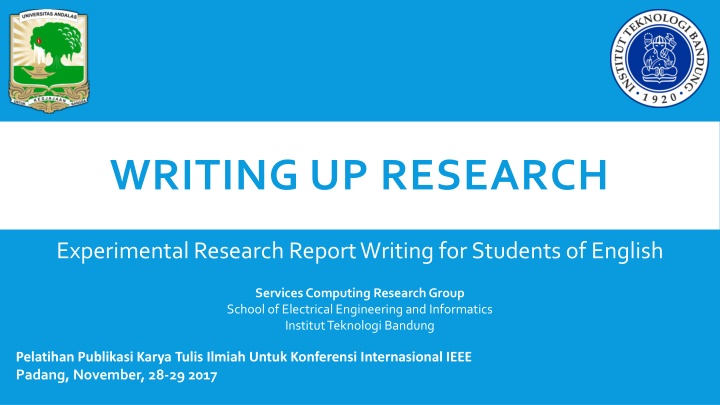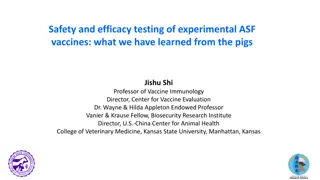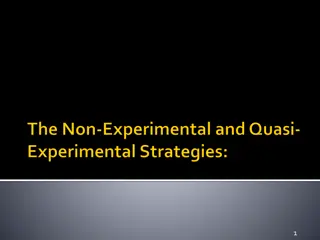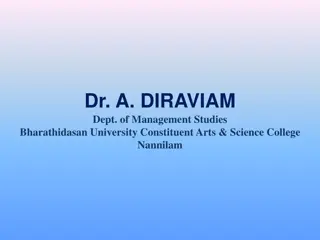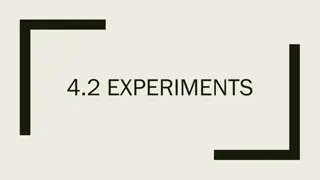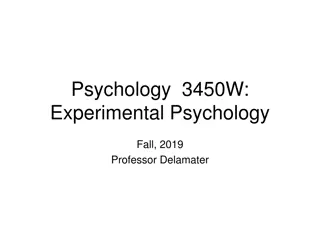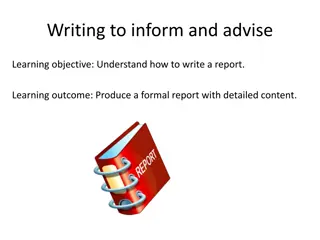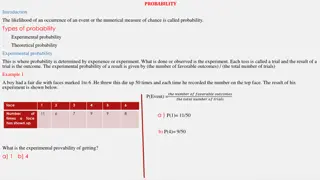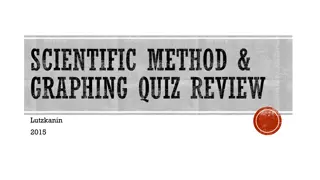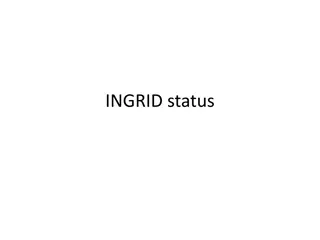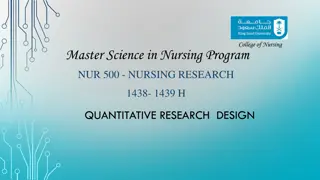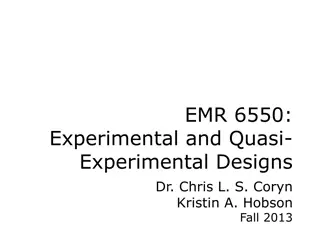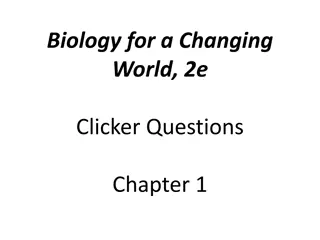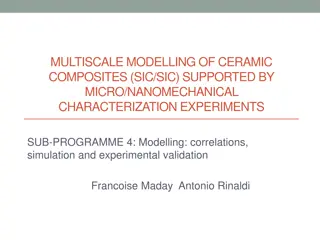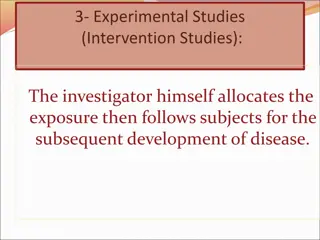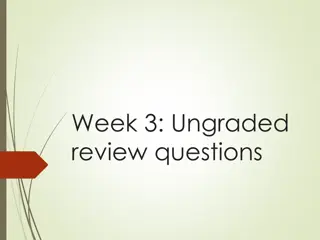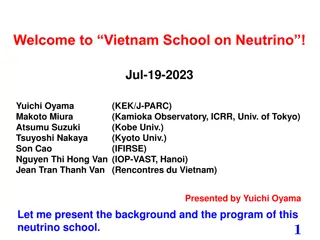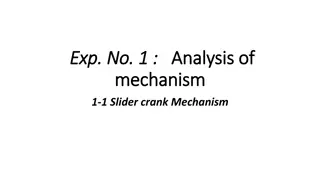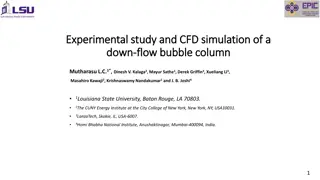Writing Up Research: Experimental Research Report Writing for Students
This report covers the essential sections of an experimental research report writing, including the abstract, introduction, method, results, and discussion. It emphasizes the importance of each section in conveying the study findings effectively to readers. The introduction is broken down into five stages, guiding students on how to structure their research effectively. The report provides valuable insights for students of English in the Computing Research Group at the School of Electrical Engineering and Informatics, Institut Teknologi Bandung.
Download Presentation

Please find below an Image/Link to download the presentation.
The content on the website is provided AS IS for your information and personal use only. It may not be sold, licensed, or shared on other websites without obtaining consent from the author.If you encounter any issues during the download, it is possible that the publisher has removed the file from their server.
You are allowed to download the files provided on this website for personal or commercial use, subject to the condition that they are used lawfully. All files are the property of their respective owners.
The content on the website is provided AS IS for your information and personal use only. It may not be sold, licensed, or shared on other websites without obtaining consent from the author.
E N D
Presentation Transcript
WRITING UP RESEARCH Experimental Research Report Writing for Students of English Services Computing Research Group School of Electrical Engineering and Informatics Institut Teknologi Bandung Pelatihan Publikasi Karya Tulis Ilmiah Untuk Konferensi Internasional IEEE Padang, November, 28-29 2017
WRITING UP RESEARCH Experimental Research Report Writing for Students of English Robert Weisberg and Suzanne Buker Prentice Hall Regents
INTRODUCTION INTRODUCTION Abstract provides te reader with a brief preview of your study based on the information from other sections of the report. The Introduction serves as an orientation for readers of the report, giving them perspective they need to understand the detailed information of your research. Method describes the steps you followed in conducting your study and the materials you used at each step. The method section is useful for readers who want to know how the methodology of your study may have influenced your results, or who are interested in replicating or extending your study. Results present the findings of your study and briefly comment on them, including only brief comments focused on the statistical analysis. Discussion indicates more extensive comments on the findings of the study, reserving the more general comments. It allows you to take a step back and take a broad look at your findings and your study as a whole. ABSTRACT INTRODUCTION METHOD RESULTS DISCUSSION
INTRODUCTION INTRODUCTION Five Five Stages Stages First Stage: General statements about a field of research to provide the reader with a setting for the problem to be reported Second Stage: More specific statements about the aspects of the problem already studied by other researchers 1st Stage 2nd Stage Third Stage: Statements that indicate the need for more investigation 3rd Stage 4th Stage 5th Stage Fourth Stage: Very specific statements giving the purpose/objectives of the writer s study (Your thesis statement) Fifth Stage: Optional statements that give a value or justification for carrying out the study
FIRST STAGE General statements
FIRST FIRST Stage: Stage: The The Setting Setting 1. 2. 3. Begin with accepted statements of fact related to your general area. Within the general area, identify one subarea. Indicate your topic in the subarea.
FIRST FIRST Stage: Stage: Strong Opening Strong Opening Statement (1) Statement (1) Strong Opening Statement: In recent years have been of great interest for The increasing interest in has heightened the need for Of particular interest and complexity are The relationship between has been investigated by many researchers.
FIRST FIRST Stage: Stage: Strong Opening Statement Strong Opening Statement (2) (2) The has become a favorite topic for analysis Knowledge of has a great importance for The study of has become an important aspect of A central issue in is The has been extensively studied in recent years. Many investigators have recently turned to
FIRST FIRST Stage: Stage: Strong Opening Statement Strong Opening Statement (3) (3) Many recent studies have focused on Recently, there has been growing interest in The possibility of has generated wide interested in The development of has led to the hope that (Notice how many of them use the present perfect. These are often general statements without citations. )
FIRST FIRST Stage: Stage: General and Specific Noun General and Specific Noun Phrases Phrases Stage 1 of the introduction usually begins with factual statements about the general area which includes your specific topic. When you write this kinds of general statements, it is conventional to use nouns that refer to objects or concepts at the highest possible level of generality. English offers several ways to construct these general nouns.
General vs Spesific Noun Phrases General vs Spesific Noun Phrases General Noun Phrases Statements in the setting of an introduction tend to be general in nature. Instead of referring to specific things, they refer to entire classes of things. Nouns referring to an entire class of things, you should use generic noun phrases. Spesific Noun Phrased Specific noun phrases are nouns that refer to particular individual members of a class rather than the class as a whole.
General Noun Phrases: Examples (1) General Noun Phrases: Examples (1) Generic Noun Phrases: Countable Nouns No one can say exactly what it looks like when a planet takes ill. Warm ocean water is like rocket fuel for typhoons and hurricanes. Environmentalists and lawyers spent years shouting at one another about whether the grim forecasts were true. As a tiny component of our atmosphere, carbon dioxide help warm Earth to comfort levels we are all used to
General Noun Phrases: Examples (2) General Noun Phrases: Examples (2) Generic Noun Phrases: Uncountable Nouns The image of Earth as organism has probably been overworked. Global warming is the real deal, and human activity has been causing it. Warm ocean water is like rocket fuel for typhoons and hurricanes. Water quality and its impact on human health have been perennial concerns
Spesific Noun Phrases Spesific Noun Phrases Specific noun phrases are nouns that refer to particular individual members of a class rather than the class as a whole. 1. Referring to assumed or shared Information. Use the definite article the if you assume your readers share knowledge of the specific thing you are referring to. 2. Referring to old information. Use the definite article thewhen referring to a specific thing which you have already mentioned (the first mention usually uses the indefinite article a/an). 3. Pointing forward to specifying information. Use the definite article the when the specific meaning is made clear in a following phrase or clause.
Referring to Shared Information Referring to Shared Information Example 1: By the end of the century, the world could be locked in to an eventual rise in sea levels of as much as 20 feet. The shared information: the century, the world Example 2: Given the complexities of the Earth s biosphere, it is inevitable that some unfolding water trends will have both negative and positive consequences. The shared information: the Earth s biosphere
Referring to old information Referring to old information Example 1: New Mexico Solar Energy Institute is developing a computerized diagnostic assistant for solar domestic hot water systems. The computer- implemented assistant will be used at naval shore facilities throughout the world. Example 2: As a tiny component of our atmosphere, carbon dioxide help warm Earth to comfort levels we are all used to. The gas represents just a few hundred parts per million in the overall air blanket. Example 3: What usually keeps the Gulf Stream running is that warm water is lighter than cold water, so it floats on the surface. As it reaches Europe and releases its heat, the current grows denser and sinks, flowing back to the south and crossing under the northbound Gulf Stream until it reaches the tropics and starts to warm again. The cycle works splendidly, provided the water remains salty enough.
Pointing forward to specifying information Pointing forward to specifying information Example 1: The forests that don t succumb to fire die in other slow ways Example 2: The gas which is produced in the western states is used primarily for home heating. Example 3: The reason that we can live here is the Gulf Stream
Example Stage 1 Example Stage 1
Summary Summary
SECOND STAGE More spesific statements
SECOND STAGE SECOND STAGE More specific statements about the aspects of the problem already studied by other researchers (Stage II supports the background information presented in Stage I.) Citation Focus When you cite the work of other authors, youmay choose to focus either on the information provided by that author, or on the author him- or herself. The first focus we call information prominent because the information is given primary importance. The author s name(s) and date of publication are parenthetically attached at the end of the sentence.
INFORMATION PROMINENT CITATION INFORMATION PROMINENT CITATION Information + Reference Examples: In most deserts of the world, transitions between topographic elements are abrupt (Smith, 1968). The literature on teaching effectiveness has established few theoretical grounds to guide the selection of meaningful variables. (Doyle, 1978) The introduction of high strength, high flexibility materials has raised the need for a dynamic approach to floor design. (1,2,8,9). Allen and Reiner (1) described graphically the differences between the various vibration scales.
Ordering of Citation Ordering of Citation Citations grouped by approach: One approach + Another approach + Still another approach
Example Stage 1: Recap Example Stage 1: Recap
Example Stage 2 Example Stage 2
THIRD STAGE Missing Information
THIRD STAGE THIRD STAGE Stage III serves to signal the reader that literature review is finished. It sums up the review by pointing out a gap that is, an important area not investigated by other authors. Usually Stage III is accomplished in only one or two sentences.
THIRD STAGE THIRD STAGE
STAGE 3: FORMULATION STAGE 3: FORMULATION Gap + Research Topic However, few studies have reported on the effects of computer assisted instruction. But there is little information the air flow rates on available on simple flat plate solar collectors.
Example Stage 3 Example Stage 3
STAGE 3: STAGE 3: SIGNAL WORDS (1) SIGNAL WORDS (1) Special signal words are commonly used to indicate the beginning of Stage 3.
STAGE 3: STAGE 3: SIGNAL WORDS (2) SIGNAL WORDS (2) Special signal words are commonly used to indicate the beginning of Stage 3.
FOURTH STAGE The Statement of Purpose
FOURTH STAGE: FOURTH STAGE: Thesis Statement Thesis Statement Stage IV serves to state as concisely as possible the specific objectives of your research report. This stage, the statement of purpose, thus follows directly from Stage III because it answers the need expressed in Stage III for additional research in your area of study.
FOURTH STAGE: FOURTH STAGE: Two Alternative Orientations Two Alternative Orientations 1. The orientation of the statement of purpose may be towards the report itself that is, it may refer to the paper (thesis, dissertation, or report) that communicates the information about the research. 2. Or the orientation of the statement of purpose may be towards the research activity or the study itself, rather than the written report.
STATEMENT OF PURPOSE: STATEMENT OF PURPOSE: Report Orientation Report Orientation
STATEMENT OF PURPOSE: STATEMENT OF PURPOSE: Research Orientation Research Orientation
Example Stage 4 Example Stage 4
STAGE 4: STAGE 4: ORIENTATION AND TENSES (1) ORIENTATION AND TENSES (1) If you choose the research orientation you should past tense, because the research activity has already been completed.
STAGE 4: STAGE 4: ORIENTATION AND TENSES (2) ORIENTATION AND TENSES (2) On the other hand, if you choose to use the report orientation, use the present or future tense.
NOTES IN STAGE 4: Research Question NOTES IN STAGE 4: Research Question Stage 4 and Your Research Question: This is your thesis statement. Your statement of purpose should be directly related to the research question upon which you based your study. Although you may not need to include the research question explicitly in your report, the statement of purpose should be written so that your reader can infer the research question behind your study. If the implied research question is a yes and no question, the connecting words whether or if are used in Stage IV, and a modal auxiliary like would or could accompanies the verb.
Implied ImpliedQuestions in Statement of Purpose (Yes or Questions in Statement of Purpose (Yes or No Question No Question) )
Implied ImpliedQuestions in Statement of Purpose Questions in Statement of Purpose ( (Information Questions Information Questions) )
FIFTH STAGE The Statement of Value
FIFTH STAGE: FIFTH STAGE: The Statement of Value The Statement of Value In Stage V you justify your research on the basis of some possible value or benefit the work may have to other researchers in the field or to people in practical situations. We can call this stage the statement of value. You may write Stage V from two alternative points of view (orientation): - practical benefits orientation and/or - theoretical importance orientation.
The Statement of Value: Practical Benefits The Statement of Value: Practical Benefits The statement of value may be written from the point of view of practical benefits which may result from applying the findings of your research. Example A: This research may provide an alternative to the problem of manually demonstrating instrumentation principles in classroom environments. Example B: The results of this study could be useful to educators responsible for planning course work in consumer education.
The Statement of Value: The Statement of Value: T Theoretical Importance heoretical Importance You may write the statement of value to emphasize the theoretical importance of your study in advancing the state of knowledge in your specific area of study. Example A: Both of the factors under investigation in this study may be of importance in explaining the irregular occurrence of this disease. Example B: Results of this study may suggest a broader hypothesis for further research into the effects of atmospheric chemicals on rubber.
Example Stage 5 Example Stage 5
STAGE 5: Model STAGE 5: Model Auxiliaries and Tentativeness Auxiliaries and Tentativeness Stage 5, the statement of value is usually written in a way that suggests an attitude of tentativeness or modesty on the part of the author. When reporting your own study, you should not sound too sure of the benefits, either practical or theoretical, of your work. It is conventional to sound more cautious. This is accomplished in Stage 5 by using modal auxilarities, principally may .
